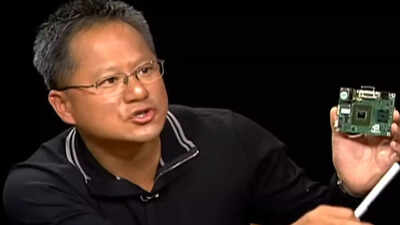ARTICLE AD BOX

In 2009, Jensen Huang offered a glimpse into the future of computing that few could foresee. During an interview, he showcased a compact chip that combines a CPU and GPU, explaining how parallel processing can outperform traditional computing methods.
At a time when GPUs were seen mainly as gaming tools, Huang envisioned them as engines for scientific research, simulations, and artificial intelligence. His insights highlighted not only the potential of GPUs but also a philosophy of innovation over competition, with a focus on investing in R&D even amid the global financial crisis. This early vision laid the foundation for Nvidia’s transformation into a global AI powerhouse, with GPUs now powering advanced systems, deep learning models, and autonomous technologies, fulfilling the bold predictions Huang made more than a decade earlier.
Jensen Huang predicted AI future with GPUs and parallel computing in 2009
In the 2009 interview, Huang introduced a compact chip capable of running Windows Vista and handling advanced graphics. He described it as a tiny low-power computer with incredible potential. This chip contained two processors, a CPU for general computing tasks and a GPU for parallel processing.Huang explained that GPUs could perform tasks far faster than traditional CPUs because they could handle multiple operations simultaneously.
He noted that the GPU he was demonstrating had 16 processors capable of 54 gigaflops, fifty-four times faster than the fastest supercomputer available in 1993. At the time, the world saw GPUs mostly as tools for gaming graphics. Huang, however, understood that GPUs could revolutionise computing by enabling complex simulations, scientific research, and eventually artificial intelligence.
Jensen Huang at Charlie Rose 2009
Jensen Huang positions Nvidia GPUs as key to AI and advanced computing
During the interview, Huang was asked about competing with Intel, which dominated the CPU market in 2009.
Rather than focusing on rivalry, Huang emphasised relevance and innovation. He said, “People talk about competition between us and Intel, but we don’t make what they make and they don’t make what we make.”Huang explained that GPUs and CPUs are complementary. The GPU enhances computing power for specific tasks, while the CPU remains essential for overall system operation. He drew a comparison to Microsoft and Google, suggesting that industry progress relies on technological relevance rather than direct competition.This approach highlights Huang’s strategic vision. Instead of trying to challenge Intel head-on, Nvidia focused on innovation in areas where it could excel. This philosophy allowed Nvidia to develop GPUs as the foundation of AI and advanced computing, without getting caught in unnecessary rivalry with other tech giants.
Jensen Huang invests in GPUs and R&D despite the financial crisis
Even in the midst of the 2009 global financial crisis, Huang doubled down on research and development.
He told Charlie Rose, “I’m going to invest more in R&D this year than last year because I believe in the future of the GPU.”At a time when most companies were cutting budgets, Huang prioritised innovation. His belief in GPUs’ potential illustrates a key principle of visionary leadership: investing in the future even when the present seems uncertain. This commitment to R&D allowed Nvidia to develop GPUs that could handle the increasing demands of AI, machine learning, and high-performance computing.
It was a calculated risk that paid off massively over the following decade.
Jensen Huang’s early GPU vision positions Nvidia at the forefront of AI
Fast forward to 2025, Nvidia’s market capitalisation has exceeded $5 trillion, making it one of the world’s most valuable companies. The GPUs Huang once demonstrated as tiny low-power computers now power AI models such as ChatGPT, autonomous vehicles, and advanced data centres.What began as a small experiment in 2009 has grown into a cornerstone of the AI revolution.
Nvidia’s GPUs have enabled breakthroughs in areas ranging from natural language processing to image recognition and scientific simulations. The company’s trajectory shows how early vision, strategic investment, and technological innovation can transform a small idea into a global industry leader. Huang’s 2009 predictions demonstrate more than just foresight, they show leadership and understanding of technological trends.
By recognising the potential of GPUs early, he positioned Nvidia to lead the AI revolution. His philosophy of standing on the shoulders of giants underscores the importance of building on past achievements to create future breakthroughs.Today, Nvidia is synonymous with AI computing. GPUs are central to deep learning, neural networks, and data-intensive tasks. Huang’s vision shows that innovation often comes from recognising potential in technologies that others overlook. The small chip he showcased in 2009 is now powering some of the most advanced systems in the world.Also Read | Meet 29-year-old Alexandr Wang: MIT dropout and Scale AI founder hired by Mark Zuckerberg to head Meta’s superintelligence labs

 1 hour ago
4
1 hour ago
4








 English (US) ·
English (US) ·